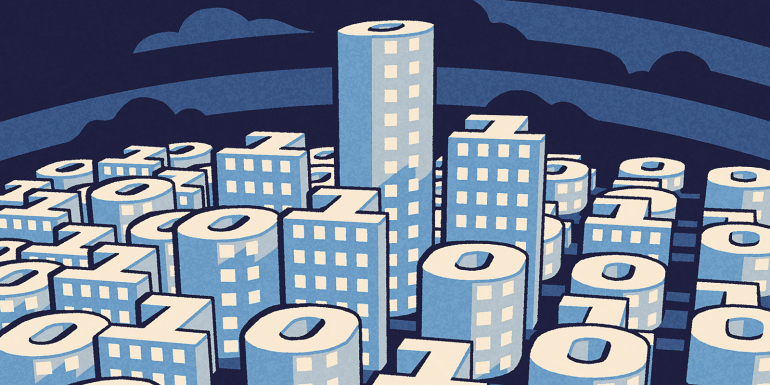The Sleeper awakes

Climate change and net zero are furrowing the brows of building owners and professionals alike. Huw Morris reports on something that can help.
Even before he founded IES (Integrated Environmental Solutions) 30 years ago, Don McLean was advocating whole-life building performance modelling. The time might have come for a refined version of the idea and many of his peers agree.
Building managers and operators must develop robust strategies to meet the two-fold challenge of reaching net zero and helping to mitigate the most serious impacts of climate change. The big issue is where to start. McLean says he has the answer. His theory is simple and set out in a white paper backed by a plethora of industry figures. IES says it is “the beginning of an important conversation”.
Look at any substantial building and there is a good chance that a 3D design and energy compliance or building information model (BIM) already exists. Often created during their design or refurbishment or to show compliance with various regulations, codes or standards, they lie dormant and are rarely used. These sleeping digital twins can be harnessed to improve the building’s performance during its life-cycle. It’s a matter of waking them up to realise their full potential.
“I have started to see a shift within the industry and momentum is building for this approach,” McLean says. “Steadily, people are becoming enlightened about the benefits it can bring in optimising operational performance and helping to reach net-zero targets.”
Mindsets across architecture, engineering and construction (AEC) professionals are shifting from a “design for compliance” approach to “design for performance”. Post-occupancy evaluations, operational models and performance ratings are now to the fore.
A survey commissioned as part of the white paper shows huge recognition of the importance of using energy models in operation. A total of 90% of AEC professionals see their value and 89% of clients feel the same. This is particularly the case in reaching net-zero targets, cited by 66% of clients and 83% of consultants. A further benefit is tackling buildings’ performance gap – the disparity between their predicted energy use and their performance once operational.
A sleeping digital twin is “not doing anything,” says McLean, “but if we wake it up, we can update the model and connect it to the operational building and end user.” For relatively little cost, he argues, “they can get the model up and running and have the operational information from it to know that the building is operating as best as it possibly can”.
Model behaviour
A survey of 243 AEC consultants, owners, occupiers and managers across the world as part of the white paper reveals:
- 82% of consultants use or create energy models for clients
- 46% of consultants go beyond compliance to create operational or calibrated energy models
- 23% have handed energy models over to clients
- 90% of consultants and 89% of clients see the value of energy models in operation
- 93% of consultants and 96% of clients agree there is a need for upskilling in the industry to take an energy model and use it in the building’s operation phase; and
- 88% of consultants and 86% of clients think there should be an online portal for energy model sharing.
From theory to reality
So what is holding sleeping twins back? The barriers are considerable. Translating the enthusiasm for change into action is the first. The white paper admits that it is “difficult for a client to employ a process that they are not even aware of”. AEC consultants say while some forward-thinking clients share their appetite for change, the majority do not understand the value of these models.
Client perception and the scale of change needed is seen as “overwhelming”, the white paper admits. Such change carries risks, which in turn breeds resistance even before new processes are put to the test. The perceived cost means clients often view ongoing updates or the introduction of new models as “a significant financial outlay”, according to AEC consultants in the survey. Resources then become a factor, particularly among cash-strapped local authorities.
The fear of change becomes most palpable with the legal landscape, the white paper acknowledges. This focuses on the potential legal ramifications “if they’ve missed something or if something is not performing the way they said it was to going to,” according to Gafcon Digital client engagement manager Todd Lukesh, who contributed to the study. This factor is cited by 58% of AEC professionals and 53% of building owners and managers.
Then there is data governance. This reveals a widespread reluctance to “introduce external work into their propriety environments, with copyright concerns adding an additional layer of complexity to model exchange,” the white paper says. Sleeping twins will, in particular, need to be checked for their accuracy and reliability before being awoken.
Another bugbear is that many professionals and stakeholders are “using computers that are not capable of using the latest modelling software” – a key barrier to linking the design and operational stages. Lack of understanding is a recurring refrain, cited by 63% of AEC professionals as a barrier to using energy models and 51% of clients. Many AEC professionals use models primarily for compliance, but are not learning how to develop modelling with a heightened focus on energy.
These key issues still need to be resolved. The debate as to who owns the energy model and its data and whether this should be shared or not is “far from over”, with the white paper acknowledging it has “simply scratched the surface”. Yet the benefits of overcoming these barriers are considerable, going beyond decarbonising buildings and reaching net zero (see Benefits of awakening sleeping twins).
There is widespread support for a best practice approach that covers the important factors with the onset of the Building Safety Act 2022 in England such as ownership, who accesses the models and where they are stored. Such an approach must tackle legal and data governance, which hamper information-sharing between stakeholders. Clients will have considerable clout if they include whole-life modelling specifications in their contracts. Yet industry bodies and consultants will also have to educate those clients about the benefits of sleeping digital twins.
“A spirit of openness is needed to thaw engrained approaches and unlock the potential we have at our fingertips,” says McLean. “There is a clear appreciation for the need for better use of digital assets. Now we need to take the first steps towards creating this change.”
Sleeping Digital Twins: Exploring the appetite, benefits, and challenges of whole-life building performance modelling is available from bit.ly/IES_sleepingdigitaltwins
BSI’s guidance document on digital twins: bit.ly/BSI_twinguidance









